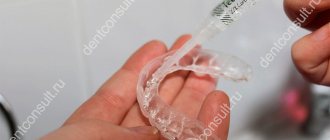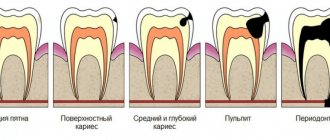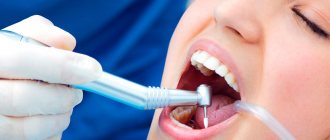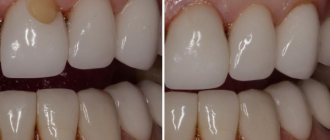Plates for crooked teeth are the most inexpensive and at the same time extremely effective way to correct the bite in children. It is worth wearing it if the baby teeth have already fallen out and permanent teeth are growing in their place, but the bite is uneven. Many parents are predictably concerned about the question of how much such records cost and whether it is possible to do without them if possible.
In a good way, treatment should be started as soon as possible. The faster you get rid of orthodontic problems, the lower the cost of medical services will be. Prices for a plate for a child will undoubtedly be lower than for installing braces for an adult. This article will look at what children's dental plates are and what justifies the prices for them.
Why do children have malocclusion?
Malocclusion in children is very common and should not cause increased concern among parents. This is not a disease, but a developmental feature, and it can be corrected quite easily. Most often, the bite is crooked for the following reasons:
- the child inherited an atypically small jaw from his parents;
- teeth erupted faster than the jaw grew;
- the baby quickly developed caries, so he had to have his baby teeth removed;
- the child often bites his lip, sucks his finger, or has other bad habits that negatively affect his bite.
Also, problems with bite occur in boys and girls who often catch colds and cannot breathe through their nose. If nasal breathing is difficult due to enlarged adenoids, the small patient has to breathe through the mouth willy-nilly, which can affect the bite.
While the teeth are still baby, you can still come to terms with the curvature of the bite. But as soon as they begin to change to permanent ones, you need to start visiting the orthodontist to prevent possible problems. The sooner you start correcting your bite, the easier and cheaper it will be to get your teeth into the correct position. Most likely, for this, the doctor will put plates on the child’s teeth.
ATTENTION:
For the manufacture of children's orthodontic plates, hypoallergenic materials that are completely safe for health are used.
Price difference
As mentioned above, plates are significantly cheaper than braces . For the first they will ask for an amount of up to 15 thousand rubles, and for the second you will have to pay from 50 thousand for a metal system and this is not the limit.
The price for some models of ceramic and sapphire devices can reach up to 150 thousand rubles and even up to 180 thousand. Moreover, this is only the price for the material itself. Add here the cost of installation and the services of a doctor who will have to be visited every month.
That's all about the difference between braces and plates. To summarize: the plates are suitable mainly for children during the formation of the bite and with slight deformation of the dentition. They are much more aesthetically attractive and significantly cheaper.
Adults with advanced problems will have to settle for braces, which do not look very nice and are very expensive. To make everything go faster and easier, it is better to take care of your teeth before the age of 25.
In any case, they will definitely tell you at the dental clinic, and you will have to listen to the opinion of a professional.
Why do we need plates on teeth?
Plates for correcting malocclusion in children are orthodontic devices with plastic bases. They reproduce the shape of the palate and the inner surface of the teeth as accurately as possible. This creates the correct conditions for the positioning of incisors, canines and molars when they change from baby to permanent.
Plates on teeth are designed to perform the following functions:
- expand the dental arch;
- correct the tilt or rotation of teeth;
- provide free space for growing permanent teeth;
- prevent displacement of the dentition;
- correct the size of the sky;
- regulate the growth of bone and jaw tissue;
- model the shape of the upper and lower jaw.
To carry out these tasks, screw mechanisms are built into the plate on the teeth. Their number and location depend on the individual characteristics of the bite. Also, the orthodontist can provide separate elements that will improve the position of individual teeth (that is, straighten their rotations or inclinations). The more such mechanisms and elements in the plate, the higher its cost.
Turning the screw one step frees up ¼ mm of space in the dentition. The child does not experience pain - he feels only slight pressure, which completely disappears after a maximum of 20 minutes.
For the sake of the child’s psychological comfort, the plates are usually made bright and cute, sometimes fairy tale and cartoon characters are drawn on them. Let the child think that this is a toy or decoration, and not a medical item - this way he will be more willing to wear it.
ATTENTION:
Such devices are most often prescribed to children under 12 years of age. However, adults also sometimes wear plates - usually non-removable.
Benefits of this treatment method
The plates enjoy consistently high popularity and are unlikely to go out of use in the foreseeable future because:
- They are light, comfortable, non-traumatic.
- They are very easy to care for from a hygienic point of view.
- They look quite aesthetically pleasing and do not cause negative emotions even in the most suspicious patients.
- Their installation and correction requires a minimum of time and effort.
- They cause virtually no pain or inconvenience to patients.
- Their cost is always kept at a reasonable level and is accessible to the widest segments of the population.
Indications for use
It is recommended to install leveling devices in order to:
- adjust the width of the sky;
- prevent further displacement;
- change the shape of the jaw bones;
- keep the units in the correct position;
- stimulate or, conversely, stop jaw growth.
You can understand that there are orthodontic problems by the following signs:
- molars, incisors or canines are crooked, located at an incorrect angle, protrude in front of their neighbors or are located behind them;
- the lower jaw protrudes strongly forward;
- rows do not close correctly;
- the upper lip protrudes.
Plate classification
The orthodontist may prescribe both removable and non-removable models. Fixed ones usually cost more. Removable ones are fixed in the oral cavity using hook elements.
Depending on their design and configuration, devices are divided into the following types:
- Single jawed. Such models successfully expand interdental spaces and also eliminate isolated dental deformations. They consist of a base, that is, a plate element, and orthodontic screws that regulate the load on the teeth.
- With a hand-shaped process. This process puts pressure on an individual tooth, giving it the right direction.
- With retraction arch. In this way, anteriorly directed changes in position are corrected.
- With pusher. This element corrects the offset towards the sky.
- Bruckle's apparatus. It is designed to eliminate malocclusion on the side of the lower jaw.
- Andresen-Goipl activator. This comprehensive correction system affects both jaws at once and thereby eliminates several problems at the same time.
- Complex Frenkel apparatus. Consists of a metal frame, lip pads and buccal shields, successfully corrects malocclusion pathologies.
The cost of devices directly depends on their design. When prescribing the optimal model, the orthodontist is unlikely to be able to listen to the patient’s financial wishes, since the simplest and most inexpensive models are not always able to cope with the diagnosed problem.
When is a filling needed?
If less than a third of the tooth is damaged, then in most cases the doctor restores it using filling materials. Modern photopolymer fillings
allow you to recreate the shape and color of a natural crown, add aesthetics to the surface, and adjust the position of the unit.
But in case of serious damage, a large filling is often (!) placed in the cavity, which will not withstand long-term significant loads. If a tooth has been depulped, then over time its walls become fragile and further destruction occurs. When the carious cavity is large, restoring the destroyed tooth crown with a regular filling is acceptable, but does not guarantee long-term preservation.
How plates are made and put on
The treatment process begins according to the following algorithm:
- The orthodontist makes impressions of one or both jaws.
- X-ray control is carried out.
- A fitting of the preliminary plaster version is scheduled.
- A permanent plate model is made.
It is important that the plastic frame fully displays the relief pattern of the dentition. The metal parts are designed to provide the most reliable fixation.
When the plates are installed on the patient, he does not experience pain. The only difficulty at first may be related to speech, to clearly pronouncing individual sounds. Also at first there is likely to be increased salivation. However, this should pass in just a couple of days.
What sensations may you feel while wearing braces?
The essence of the process of correcting occlusion anomalies is that, under the pressure of a power arc, the teeth begin to move in a given direction. In this case, the bone tissue of the jaw begins to dissolve on one side and grows on the other. This process is accompanied by the response of nerve endings, the signal from which is sent to the brain. As a result, the person feels a pain reaction. We can conclude that pain during treatment is natural. Therefore, you should not be afraid of her. Over time, the body adapts: the pain will either stop altogether or will be felt as a slight discomfort.
How to care for the plate
The removable product must be removed before eating, playing sports or intense physical activity. The product should not be removed while sleeping, as this will delay the treatment process. As for whether it is necessary to remove the device while eating, there is no clear answer: the doctor will have to make an individual recommendation. It should be taken into account that most plates can be stained by food.
The record must be stored in a special sealed container, which will be provided by the orthodontist. Wrapping the device in a cloth or paper napkin is strictly prohibited: practice shows that you are likely to break it or accidentally throw it away.
Clean the plate twice a day, after waking up and before going to bed. To do this, it will be enough to use a regular toothbrush and toothpaste. Many brands produce specialized liquid and tablets for the care of such devices.
ATTENTION:
When cleaning, you need to pay special attention to the places where the screws are located. This is where food debris most often accumulates and creates a favorable environment for the proliferation of pathogenic microorganisms.
During the day, you should rinse your mouth as often as possible to eliminate bacterial plaque that contributes to the development of caries. You should brush your teeth in the morning and evening while wearing the plate especially long and thoroughly. If tartar is found on the device, you should inform your treating specialist, and he will give advice on how to remove it.
How long do you wear a dental plate?
Typically, teeth straightening plates are worn for 6 months to 1 year. It all depends on the individual characteristics of the bite, as well as the regularity and duration of wearing the product.
The period of getting used to the plate lasts about 2 weeks. First, the orthodontist makes the product according to individual measurements and shows the little patient where her clasp feet are located and how to use them. Children should learn to put on and take off the plate themselves from the very beginning. However, the less they wear it and the more often they take it off, the longer the treatment will last. Parents should explain to the child that removing the plate is only allowed for a short time.
Under no circumstances should the plate compress or injure the teeth. The force exerted by it remains minimal throughout its wearing. The child should never experience pain or suffer from constricted circulation inside the mouth. The duration of wearing is primarily due to the fact that the teeth move into the correct positions smoothly and gradually. They will then need some time to “get used to” their new places.
ATTENTION:
During the course of treatment, the child will need to be brought to the clinic for examination once every 1-2 months.
Why trainers are better than other orthodontic devices
Compared to other orthodontic devices, teeth straightening trainers benefit in three ways:
- They do not need to be worn constantly like braces. Therefore, you don’t have to limit yourself in communication or refuse to work with people. At school, children will not suffer from ridicule from classmates;
- they do not put pressure on the teeth. Braces and plates affect the teeth, destroying the enamel and injuring, irritating the mucous membrane;
- they are much cheaper and do not require individual production. The patient can buy a trainer in a store (for example, choose it from the catalog on our website) and immediately start wearing it.
Another plus is that you don’t have to wait for the trainer to be made. All you need to do is ask your doctor which model and size you need, and order it in the store. This is also different from braces, the installation of which takes a lot of time.
What is the price of a dental plate?
A plate for straightening teeth is the most inexpensive way to correct a bite. With this method of treatment, the doctor does not have to stick a bracket on each tooth, which takes quite a lot of time and money. Adjusting the plate also takes much less time than adjusting each bracket individually.
Quite often, thanks to just one plate, the bite can be completely corrected. If the problem was too serious, there is a chance that the patient will still have to wear braces during adolescence. However, the duration of wearing them will be significantly less than if the child did without the plate in childhood - which means the cost of orthodontic services will also be lower.
ATTENTION:
After wearing fixed braces during adolescence, wearing a plate may be necessary to consolidate the effect. This will not depend on whether the child wore the record as a child.
The doctor’s opinion is that the operation itself is completely painless
Before installing a dental implant, patients often worry about the procedure and how they feel in the dentist’s chair. But there is no discomfort at all; the patient can only feel slight pressure or vibration. If we compare the procedure with tooth extraction, the latter feels much more unpleasant. For anxious patients, you can take a course of premedication before surgery.
Levin Dmitry Valerievich
Chief physician, Ph.D.










